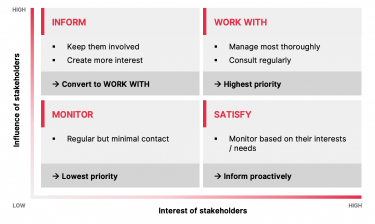
#dpm #events #productmanagement
13. Feb 2020 |
- min Lesezeit
Managing your stakeholders properly is essential to create an efficient and collaborative product development environment. In this article, I don’t want to tell you the things you might already know about how stakeholder management could be done properly, but during the last weeks and with the books I read, I want to share some thoughts that can improve your way to manage your stakeholders.
To manage your stakeholders, it is crucial to understand first who they are and how to deal with them. In the so-called Stakeholder Map shown below, you can cluster your relevant parties based on their influence and interest in your product or project.
That means how much power does a specific person have to influence your product or project and are they highly interested or not. Typically you would start with a brainstorming session to identify potential stakeholders you have in your current setup. But to keep it simple, let’s picture one very obvious stakeholder:
Undisputed, Mrs. Smith as CEO has a lot of power to highly influence your product and/or project. By changing the overall company strategy or vision, it might directly affect you and your work.
In that imaginary scenario you know the CEO is highly interested in the product as well because it was her idea and she wants to see the progress of her “baby”.
Therefore Mrs. Smith should be managed with the highest priority and most thoroughly. This could be achieved by involving her in regular (but only relevant) meetings or even better by having four-eye sessions to keep her informed and involved.

But what does empathy or being empathic actually mean? The official definition you can find in a one-minute-Google-search:
“Empathy, the ability to understand and share the feelings of another person.”
It seems to be pretty simple, if you are in your personal environment, for example: A friend is coming along and tells you that something bad happened, they become sad and you’re feeling sad as well. But it gets harder thinking of a business context. Therefore I want to emphasize that empathy is no superpower to have or not to have. How often did you hear in the past about people judging if someone is empathic or not? For me, it happens quite too regularly and it’s not surprising that I don’t like the concept of being empathic as a black-or-white ability.
As always, the source of progress: repetition, repetition, repetition.
Especially when it comes to difficult conversations, it is very beneficial to have an empathic mindset. To prepare yourself and get in the right mood of objectivity, picture yourself outside of the window. Try to be a ghost, who flies out of the window and have a look at the current situation. Starting from an objective point of view helps to understand the other person’s situation even better. Once you set yourself into the position of objectivity, you can use six simple questions, explained by Michelle Stowe, in a discussion to practice your empathy even more. But to get started I want to highlight the three most powerful for me:
1. What do you think happened?
2. How could it be done differently in your opinion?
3. What do you think needs to be done next?
In general, those are very simple questions with one common goal: discover the context of the specific situation. By understanding the context and listen to the thoughts of your peers, you will enable yourself to think about the whole situation rather than just your own perception. If you want one thing to take away from this: start raising questions in order to explore the context. You can use the questions above or find the ones that fit best for you.
“
“All big things come from small beginnings. The seed of every habit is a single, tiny decision. But as that decision is repeated, a habit sprouts and grows stronger. Roots entrench themselves and branches grow. The task of breaking a bad habit is like uprooting a powerful oak within us. And the task of building a good habit is like cultivating a delicate flower one day at a time.”
“
While I was searching for some inspiration on Youtube, I found a talk by Prof. Dr. Jack Nasher from the Munich Business School about how to better negotiate. Besides some helpful tips and funny examples, he mentioned the theory of interest-based negotiation.
Actually, this is nothing new. Roger Fisher and William Ury have created the Harvard Negotiation Project in 1978 and introduced their theory of principled negotiation in their book Getting to Yes: Negotiating an agreement without giving in.
We all know that discussions and decisions can be emotional sometimes and have some chance to escalate. That’s the situation where we start to insist on our position, give in or propose compromises to get out of that discussion with a black eye. By understanding the basics of principled negotiation will help you deal with your stakeholders on a non-emotional level.
Let me try to make it more clear by referring to Prof. Dr. Jack Nasher: “The best negotiator insists on his interests rather than his position.” We need to understand, that for most of our interests there can be several positions and maybe you can find a position that fits you and your stakeholder’s interests. Adapted from Fisher and Ury, there is one striking example, but very bold and simple to be honest: The Orange Quarrel
Summarizing the four key aspects of principled negotiation:
Separate the problem from people
Focus on interests, not positions
Generate options, before making the decision
Use objective criteria
By identifying who your stakeholders are, understanding the context of the situation and trying to negotiate with them based on interest will enrich all the things you already know about proper Stakeholder Management. If you liked what you read or even better you’re now inspired and want to know more, check out my book recommendations below:
Getting to Yes: Negotiating an agreement without giving in
